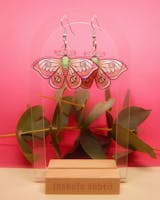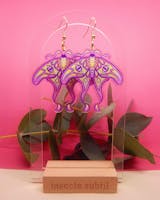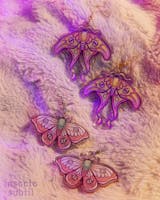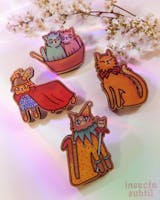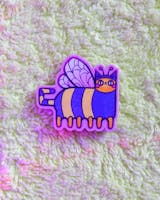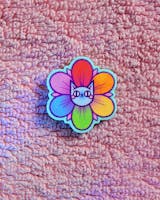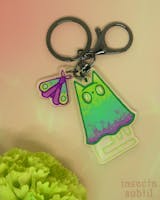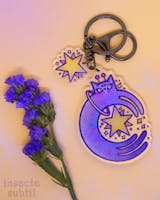This tutorial contains everything you need to know about creating your own printed wooden magnets using Adobe Photoshop.
1. Download our templates
To start submitting your custom printed magnet designs you’ll need to download our design templates. Templates are available in various sizes ranging from 25mm (1 inch) up to 75mm (3 inch).
Download our Photoshop templates >> here << and open your chosen size.

Each template comes with a working area where you will import or create your designs. Please make sure that your artwork fits INSIDE of the grey borders.
2. Understanding our layers
Opening the template, you will notice that there are 6 layers in your Layers palette. If you can't see the Layers palette, hit F7 to make it appear.

IMPORTANT - Please don't rename existing layers or create additional layers as this will confuse our systems when processing your designs.
If you have used any effects / layer styles on any of your layers you MUST flatten them before saving. To do this simply right click on the applicable layer and select 'Rasterize Layer Style' from the menu.
'Office Use Only' Layer
This layer contains the blue borders which your design must sit inside, our logo and a brief description of the template size that you are using. This layer is locked and should not be used.
'Artwork' Layer
This layer is where you should place your artwork. Please make sure that you choose the correct template size and that your artwork fits neatly inside the blue borders.
'White' Layer
Adding a base layer of white to your designs will make your colours crisper and more vivid. Use this layer to show us where you would like this layer of white to go.
'Gloss Varnish' Layer
If you would like your designs to have a gloss finish as opposed to a matte finish, you can use this layer to show us where you would like the your areas of gloss to be placed.
‘Cut Area’ Layer
Use this layer to show us where you would like your designs to be cut. We'll use this information to create a path which will then be used to create a cut line for our laser cutters.
'Magnet Template' Layer
Use the magnet template layer to check if the 15mm disc magnet will fit onto the back of your magnets.
Please note that the magnet template is for checking that your designs are large enough to accommodate the disc magnet only, and is not used to show the position of the magnet.
3. Importing your designs
Select the 'Artwork' layer in your layers palette and either draw your design directly on this layer or, simply copy (CTRL+C) and paste (CTRL+V) previously saved artwork.

If your artwork goes right up to the edge of your cut line or if you would like a coloured border, you will need to add at least 1mm of bleed to your design. See 6b for more information on bleed.
4a. Adding a layer of white
To guarantee bright and crisp colours for your artwork, you will need to add a white base layer to your designs. This white layer will sit behind your artwork and will ensure that the colours of your designs are consistent, regardless of what material you choose.
Check out the charms below by jwhitneyart.com. Using a white base layer of ink means their designs look the same on our white and black acrylics.

Please note that we ask that you create this white layer for ALL of your designs.
To create your white base layer simply hold down the 'CTRL' key and click on the thumbnail of your 'Artwork' layer. This will select all of the elements of your artwork layer.

Inset your selection by 2 pixels using SELECT > MODIFY > CONTRACT and enter the value of 2 in the pop up 'Contract Selection' window.
Insetting your white layer by 2 pixels will prevent any areas of white from showing around the edge of your designs.
Now go to EDIT > FILL (Shift & F5) and select the 'Color' option from the 'Content' drop down menu.

Choose 100% Cyan as your colour (C:100 M:0 Y:0 K:0)
Click 'OK' and 'OK' again. You should now have a Cyan silhouette of your original artwork, placed on your 'White' layer
Be aware that contracting your selection in this manner can have an effect on the pixels selected. Always zoom in on areas with fine details such as strands of hair or small point text and check that you are happy with the results.
You may decide to only contract your selection by 1 pixel if you have a lot of fine or intricate areas in your designs.
Please remember that we always recommend ordering samples before committing to large print runs, so that you can check that you are happy with the result. mistakes can not be rectified once your charms have been printed.
4b. Identifying unwanted areas of coloured ink, white ink & varnish
Using soft brushes in Photoshop can result in unwanted, low opacity pixels causing issues around the edges of your artwork.
These pixels can be invisible to the eye but get picked up by our printers, which print ALL pixels on your white and gloss layers, no matter how low their opacity, as 100% white or 100% gloss. This can cause unwanted areas of white ink and gloss varnish around the printed edges of your finished charms.
A simple way to check your artwork for low opacity pixels is to click on your artwork, white and gloss layers, select the paint bucket tool and fill the background black.

The paint bucket will fill all areas of the background, except where there are any low opacity pixels. These can then be easily identified and removed using the selection and eraser tools.
IMPORTANT - Please remember to undo the black paint bucket fill before submitting your designs.
5a. Working with gloss varnish
You can choose to have a gloss or matte finish on your designs by selecting the matte or gloss option when placing your orders.
If you choose 'Gloss' as your option, you will need to create a grey silhouette on the 'Gloss Varnish' layer, similar to how you created the cyan silhouette on your 'White' layer in step 4 of this tutorial.

Copy your artwork from the 'Artwork' layer and paste it into the 'Gloss Varnish' layer using the 'Paste Special' command SHIFT + CTRL + V.
With the 'Gloss Varnish' layer selected, click on the 'Lock Transparent Pixels' icon.
![]()
Now go to EDIT > FILL (Shift & F5) and select the 'Color' option from the first drop down menu. Enter the following colour values to create a grey fill C:0 M:0 Y:0 K:50
Click 'OK' and 'OK' again. You should now have a grey silhouette of your original artwork, placed on the 'Gloss Varnish' layer.

5b. Spot gloss varnish
As well as being able to add gloss varnish to your entire design, you also have the option to limit this to certain areas, in effect highlighting particular elements of your design. Handy for creating textures like water droplets or snakeskin.

To do this, simply delete any unwanted parts of the grey silhouette that you created in step 5a. or create a custom silhouette based on the areas of your design that you would like to highlight.
6a. Adding a border / cut line - Important!
Show us where you would like your designs to be cut out by creating a black silhouette on your 'Cut Area' layer. If your design runs right up to the edge of your cut line read 6b. Adding bleed.
To create your cut line silhouette simply copy your artwork onto the 'Cut Area' layer. Select the 'Lock Transparent Pixels' icon.
![]()
Use the 'Fill' command (SHIFT+F5) or EDIT > FILL and fill this area black. This colour will not be printed, it's simply for our designers to use as a guide when creating your cut line.
TIP - Use the paintbrush to cover any areas missed by the 'fill' command!
6b. Adding bleed
If your artwork goes right up to the edge of your cut line or if you would like a coloured border, you will need to add at least 1mm of bleed (colour that extends past the cut line) to your designs to prevent any unprinted edges from showing on your finished designs.
Here is an example with bleed added. The red line represents the cut line.

Extending the colour of the design past the cut line will help to minimise visible unprinted edges.
Please don't rename existing layers or create additional layers as this will confuse our systems when processing your designs.
If you have used any effects / layer styles on any of your layers you MUST flatten them before saving. To do this simply right click on the applicable layer and select 'Rasterize Layer Style' from the menu.
7. Check your charm size
Use the magnet template layer to check if the 15mm disc magnet will fit onto the back of your designs.
Please note that the magnet template is for checking that your designs are large enough to accommodate the disc magnet only, and is not used to show the position of the magnet.

8. Submission checklist
Congratulations, you've finished creating your custom magnet designs. All you have to do now is check the following before submission...
- Your white base layer is 100% Cyan and located on the 'White' Layer (Step 4a.)
- Your gloss varnish layer is 50% Black and located on the 'Gloss Varnish' layer (Step 5a.)
- You have checked for unwanted elements using the steps at 4b.
- The charm design is larger enough to accommodate the 15mm disc magnet.
- Bleed of at LEAST 1mm has been added where designs go right to the edge of the cut line.
- All text has been converted to outlines.
- Your design template contains 1 charm only. Additional designs will be sent separately.
9. Saving and submitting your designs
There are 3 different ways to save and submit your designs...
1. Submit your artwork immediately
If you have already created your designs, you can send them to us using the 'Upload Artwork' button, located on our product pages or by emailing them to ‘info@zapcreatives.com’.
Save all Photoshop files in .Psd format. Here’s how…
Name each of your designs appropriately so that we know which designs you are referring to. Your file names should include 1. your name, 2. design number, 3. chosen product and 4. the date that you placed your order through our website. Here’s an example…

Select all of the designs that you would like to submit, right click and choose SEND TO > COMPRESSED (ZIPPED) FOLDER.

This will create a compressed folder containing all of your designs. Rename this folder so that it contains your name and the date that you placed your order on our website. Like this…

Please add all of your designs into one folder. So, if you purchased charms, stickers and pins, for example, just pop them all in the same, compressed folder and upload it using the 'Upload Artwork' button.
2. Submit your artwork later
If you have placed your order via our website but your designs aren’t quite ready yet, that’s ok. You have up to 2 weeks to submit your artwork to us, which allows you to take advantage of any special offers that we’re running.
To submit your designs later, save them with 1. your name, 2. design number, 3. chosen product and 4. your order number. Then email them to ‘info@zapcreatives.com’.
Save all Photoshop files in .Psd format. Here’s how…

3. Placing a re-order
If you have placed an order in the past and would like to re-order those designs that’s great! We store your artwork for a maximum of 6 months, which saves you the hassle of having to resubmit your designs via email.
To place a re-order, simply place your order online, email us with your previous order number(s) and let us know that you are placing a re-order.
You may only want to order 1 or 2 designs from your previous order(s). To do this simply quote your old file name(s) and let us know how you would like them producing and in what quantities.
Here’s how to do it…
Hi Zap!,
I’ve just placed an order #12345 on your website and would like to re-order the following designs from a previous order #12121. Please can I have…
10x [YOURNAME]-DESIGN1-CLEARCHARM-12121
20x [YOURNAME]-DESIGN2-WALNUTKEYRING-12121
10x [YOURNAME]-DESIGN3-ACRYLICPIN-12121
Thanks!
[YOUR NAME]
If you have any questions about this tutorial or any other aspects of our website and manufacturing processes, please do not hesitate to get in touch. We’d love to hear from you.

